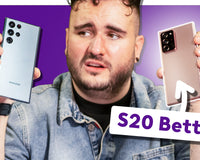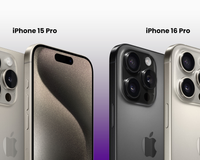Market Impact of New iPhone Launches on Previous Models
The launch of the iPhone 16 is fast approaching (Monday, September 9th), and it’s set to shake things up in the resale market.
If you're wondering how the iPhone 16 launch could dramatically impact your current iPhone's value, you're not alone. Understanding resale market dynamics before a new model hits the shelves can make a significant difference in your wallet.
TLDR: if you're planning to upgrade - trade-in your old device quickly, before the new one is launched and available in stores, in particular if you have last year's model. If not, stay put for a while.
Resale Market Dynamics
When a new iPhone model launches, older models typically see an immediate drop in their resale value. This is driven by several factors:
- Anticipation of New Technology: Some people crave the latest tech features, making older models less appealing.
- Increased Supply: Early adopters rush to upgrade, flooding the market with used devices.
- Price Adjustments: Retailers reduce prices to clear out inventory and stay competitive.
Why It Matters
Recognising these factors before the iPhone 16 release can help you make smarter decisions about when to sell your current device. If you wait too long, you might find that the resale value has plummeted, costing you hundreds of pounds.
Historical Trends: Price Drops for Older iPhone Models
Understanding historical trends gives us an idea on how the iPhone 16 launch might impact your current device's value. Let's look how past launches have affected older models, focusing on the iPhone 15 as a case study.
Case Study: Price Drops Seen with the Release of the iPhone 15
When Apple introduced the iPhone 15, resale prices for older models like the iPhone 14 and iPhone 13 took a noticeable hit. Here's what happened:
- Immediate Decline: Prices for the iPhone 14 dropped by around 20% almost instantly.
- Further Reductions: Within weeks, these prices fell another 10% before stabilising.
- Holiday Uptick: During Christmas, there was a slight bump in resale values by about 5%, reflecting increased demand.
These fluctuations highlight how quickly the market reacts to new releases. If you're considering selling your iPhone, timing your sale is crucial.
Expected Trends with the Upcoming iPhone 16 Launch
Based on previous trends, here’s what you can expect when the iPhone 16 hits the market:
- Latest Models: Expect a significant drop in resale value for devices like the iPhone 15 series. Historically, these can dip between 20-30% shortly after a new launch.
- One-Year-Old Devices: Models such as the iPhone 14 series might see a reduction of around 10-20%.
- Older Devices: For models like the iPhone 13 or earlier, the price decline tends to be smaller but still noticeable.
These trends suggest that if you're planning to sell an older model—whether it's to sell your iPhone 11, 12, XR, sell another broken iPhone, or even to sell an iPhone 13/14 —being proactive is key.
Impact on the Second Hand iPhone Market
Beyond official Apple and retailers price reductions, the secondhand market for iPhones goes crazy when a new model launches. The resale value of iPhones, particularly the most recent models like the iPhone 15 series, often takes a nosedive in the days immediately following the announcement of the new device. This drop in price is driven by both anticipation and availability of the latest model, as consumers begin upgrading to the newest model and flooding the market with older devices.
Immediate Price Decline
Once the iPhone 16 is announced, expect a sharp and immediate drop in resale prices for the iPhone 15 series. Early adopters, eager to upgrade, will list their current phones for sale, leading to an oversupply of older models, which pushes prices down.
Gradual Stabilisation
However, this initial price decline is often temporary. After the rush to sell settles, the resale market typically evens out within a few weeks or months, with prices settling at a new baseline. While prices remain lower than pre-launch levels, they tend to level off as demand for used phones stabilises.
For example : Last year, on the launch of the iPhone 15, we saw an immediate 20% hit on the iPhone 14 range. This meant the stock we were holding for these products got cheaper in the resale market, and we dropped our prices accordingly.
To respond, we lowered the trade-in price offered to customers to compensate, slightly more to remain competitive. This took a steeper dive the weeks after (around 10%) as lots of supply flooded in (basically lots of people trading in their device) creating an immediate supply shock before stabilising and rising again slightly around 5%. The impact around Christmas overall was 28%.
Typical Price Reductions Across Current Models Post-iPhone 16 Launch
With the iPhone 16 on the horizon, it's crucial to prepare for the anticipated price drops for existing models. Historically, new iPhone announcements lead to immediate and substantial depreciation in the value of older models as mentioned above.
Here are some specific examples:
- iPhone 15 Series: Expect a significant drop in resale value, typically around 20-30%. Early adopters rushing to upgrade will flood the market with used iPhone 15 units, driving prices down.
- iPhone 14 Series: Anticipate a 10-20% decrease in trade-in price. These models are slightly older but still face competition from newer releases.
- Older Models (iPhone 13 and Earlier): The depreciation for models older than three years is generally less dramatic, with only slight reductions in their resale value, as they have already seen significant depreciation over time.
Retail Price Adjustments
Apple strategically reduces the retail prices of previous models to clear inventory and remain competitive against mid-range smartphones. For instance:
- After the iPhone 16 announcement, expect older models like the iPhone 14 to see retail price cuts ranging from £100-£200.
- Retailers often offer additional discounts and promotions to move stock quickly.
One weird and wonderful thing with older generations is appreciation in price. Usually, we see an increase in price for what we call n-2, which is the model 3 generations behind the current.
What typically happens here, as did with the iPhone 12 when the 14 arrived, and as did the iPhone 13 when the 15 arrived is an increase in price. This device lands in the sweet spot of pricing, typically in the £300 range and becomes the popular device to buy, leading to supply shortages and pushing the price up.
Factors Affecting Resale Value
Several elements influence how much you can get when you sell your iPhone 14 or other recent models:
- Condition: Devices in excellent condition fetch higher prices.
- Storage Capacity: Higher storage variants (e.g., 256GB vs. 64GB) command premium prices.
- Colour and Special Editions: Limited edition colours or collaborations can hold their value better.
- Accessories: Including original accessories (charger, headphones) can boost resale value.
Understanding these dynamics helps in making informed decisions about when to sell your current device. Keep an eye on Apple's announcements and market trends to maximise your return.
When Is the Best Time to Sell Your Current iPhone?
Knowing when the best time to sell your iPhone is will help you get the most for it. The market dynamics shift rapidly with new model announcements, especially with the upcoming iPhone 16 launch. Here's how you can strategise:
Best Practices for Selling Older Models
iPhone 11, 12, or 13 Strategies
- Given the expected price drops post-iPhone 16 launch, consider selling your iPhone 11, 12, or 13 shortly after the announcement. This can help you leverage any initial demand surge for slightly older models.
- These devices may see smaller reductions (usually <10%) compared to newer models like the iPhone 14 series.
Timing Your Sale
- For newer models (e.g., iPhone 14), selling just before the iPhone 16 announcement might yield the best returns due to high demand and limited supply.
- For older models (e.g., iPhone 11), waiting a few months post-launch can sometimes result in better prices as the initial influx of trade-ins slows down and demand stabilises.
Market Timing Insights
Before vs After Launch
- Before Launch: High demand and lower supply make this period ideal for sellers. Prices are more stable.
- After Launch: While initial prices drop due to oversupply, waiting a few months can pay off as market stabilises and holiday season demand kicks in.
By considering these strategies and timing your sale right, you can maximise your resale value. Stay informed, monitor trends, and act decisively when selling your current iPhone.
What's the best way to sell?
Trade-In vs. Direct Sale
When you decide to sell your iPhone or trade in your iPhone, you have several platforms at your disposal. Each has its pros and cons, so evaluating them is essential.
1. Trade-In Programs
Trade-in programs are convenient options that allow you to exchange your old device for credit towards a new one. Here are some popular trade-in programs:
- Reboxed Trade In Program: trade in your old iPhone direct with us competitive market prices and an easy upgrade path to the latest model. Visit our trade-in site here.
- Apple Trade-In: Apple's own program allows you to trade in directly for store credit or a new device offering lowball pricing.
- Carrier Trade-Ins: Many carriers offer trade-in deals that can lower your monthly bill or provide credits towards a new phone.
2. Direct Sales
If you're looking for higher returns and are willing to put in more effort, selling directly to buyers might be the better option for you. Here are some avenues for direct sales:
- Online Marketplaces: Platforms like eBay, Gumtree, and Facebook Marketplace allow you to set your price and negotiate directly with buyers.
- Specialised Websites: Websites like Swappa offer a more streamlined experience than traditional marketplaces, specifically targeting tech enthusiasts looking for used devices.
Don't Miss Out on the Opportunity to Upgrade and Maximise Your Phone’s Resale Value
Assess your current device now. The impact of new technology on older devices is undeniable, and with the iPhone 16 launch, your current iPhone's value could drop dramatically. By acting swiftly, you can avoid significant depreciation.
Consider selling or trading in your iPhone before the market adjusts post-launch. Reboxed offers a competitive market price for trade-ins, making it an excellent option for upgrading to the latest model. Visit Reboxed's Trade In program here to get started.
Here's why Reboxed is your best bet:
- Competitive pricing: Get a fair value for your old device.
- User-friendly process: Simple and straightforward steps to trade in.
- Fast upgrades: Quickly move to the latest iPhone model without hassle.
Act now to secure the best deal and stay ahead of the curve. Don't let your current iPhone's value plummet. Upgrade and make the most of what you have!
For more details, check out our trade-in website here.






![The Best iPhones for battery life ranked [2025]](http://reboxed.co/cdn/shop/articles/IPHONE-BATTERY_e2de6230-b1d2-4348-ac33-e47d1e267bdd_100x80_crop_center@2x.jpg?v=1738489925)






